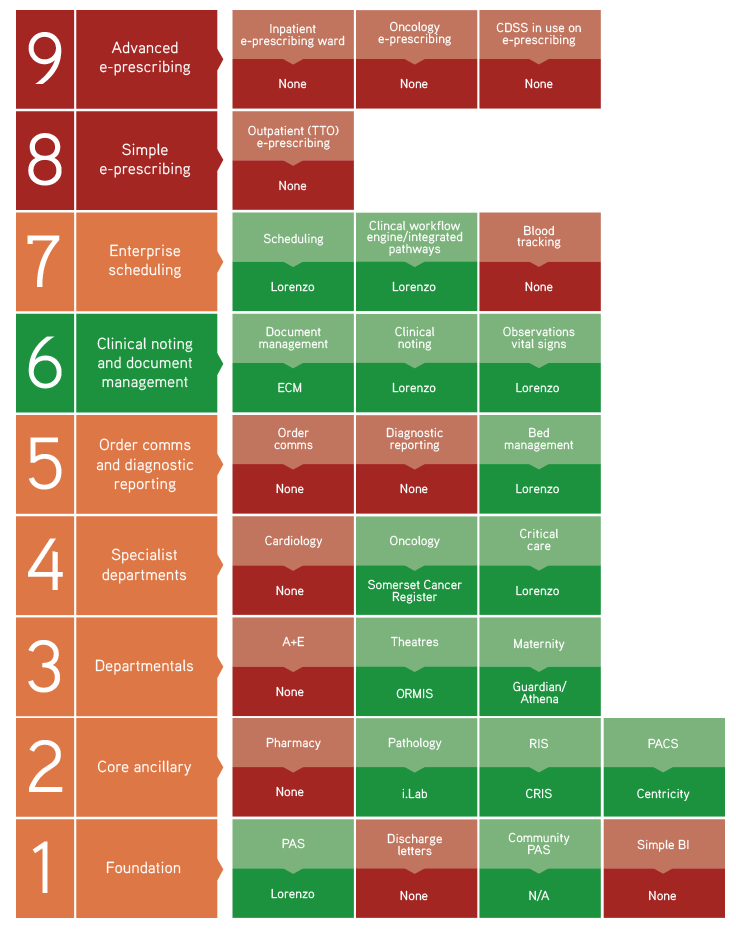The National Health Service (NHS) England continues to work towards the ambitious target of achieving a paperless environment by 2018. While many people working in the NHS doubt that they will ever be completely paperless, the fact that there is a target at all is a positive move. Eradicating paper and paper processes will lead to improved patient outcomes, less bureaucracy and improved patient safety and will deliver both efficiencies and cost savings in the long run.
Healthcare is already a data-rich industry. Hospitals collect huge amounts of data ... basically everything that happens to the patients is collected in some form or other. However, this data is usually not available when and where it’s needed and cannot easily be used for decision making. That's a major challenge.
Two key initiatives driving change are:
Clinical Digital Maturity Index (CDMI)
In order to measure the progress, NHS England has partnered with EHI www.ehi.co.uk to develop a unique benchmarking tool called the Clinical Digital Maturity Index (CDMI) that enables the 160 NHS Trusts to benchmark their investment, deployment and uptake of IT systems and to understand how they’re positioned against other Trusts. At the moment, Kings College NHS Trust, Liverpool Heart & Chest NHS Trust and Newcastle upon Tyne NHS Trust are joint top of the ranking, all having rolled out e-prescribing.
The model is broken down into nine levels and analysed by order of penetration and use of system. NHS Trusts are then ranked and are encouraged to move up the ranking by investing more in technology.
 A similar tool has been in use in the US which has been promoted by HIMSS – this was explained by Slainte’s Dr. Jean Evans in an ‘Insight’ for www.slaintehealthcare.com/insights-information/insights recently. The HIMSS model hasn’t really been applicable in the UK market and it is felt that the CDMI is a more appropriate tool. Both are useful and encourage transparency within hospitals so everyone can see how well they are doing with regard to deploying technology.
A similar tool has been in use in the US which has been promoted by HIMSS – this was explained by Slainte’s Dr. Jean Evans in an ‘Insight’ for www.slaintehealthcare.com/insights-information/insights recently. The HIMSS model hasn’t really been applicable in the UK market and it is felt that the CDMI is a more appropriate tool. Both are useful and encourage transparency within hospitals so everyone can see how well they are doing with regard to deploying technology.
While the CDMI will probably create some competition between NHS Trusts, the stated aim is that it will “inspire organisations to work together, with all Trusts sharing expertise and learning from each other’s successes”. There may be some negative impact for some suppliers. If Trusts decide only to work with companies that are already supplying say the top 20 Trusts and all of that information is readily available to them via the CDMI then this will potentially restrict the market and make it even more difficult for new more innovative solutions and suppliers to enter.
Chief Clinical Information Officers (CCIO)
Another initiative from EHI which has been embraced by a growing number of NHS Trusts is the encouragement and establishment of a new role – that of the CCIO. This new role will focus on ensuring that clinical leadership is central to the way hospitals manage their information systems. The appointment of a CCIO will ensure that there is direct clinical involvement in technology and information so that quality of care is at the heart of IT.
These positions are usually filled by clinicians with a passion for IT and from a supplier’s point of view should be a key target group. As clinicians, they are familiar with the problems that paper processes bring and as IT experts, they can understand how rapidly solutions such as Vitro could solve these problems.
Conclusion
There are many activities ongoing in the NHS, all with the ultimate goal of improving patient outcomes and safety. There are also a large number of vendors offering a multitude of solutions which can be a challenge for hospitals to interpret. The CDMI will allow Trusts to see what their peers are doing and encourage them to share information and continue on the road to a fully digital environment.
On the supplier side we must continue to improve at showing how our solutions will allow data to be turned into real information for decision making and deliver against the stated NHS objectives while showing a clear ROI.
All in all it is an exciting time ahead and one that will ultimately benefit patients and time will tell how this will impact suppliers, especially those new to the market.
Canice McKee - Business Development Manager Ireland & UK, Sláinte Healthcare
Canice is responsible for growing Slainte Healthcare’s business within the UK and Ireland. During a successful 6 years at Lincor Solutions Canice won many contracts for their bedside computing solution in hospitals across UK, Ireland and the Middle East, developing an understanding of how technology can improve patient outcomes. Canice’s background prior to becoming involved in Healthcare was in the Mobile Communications market, where he held senior global marketing positions with Nokia and sales and marketing roles with BT and Orange. Canice is a Business graduate and is a Member of the Institute of Marketing
LinkedIn: http://ie.linkedin.com/in/cmckee